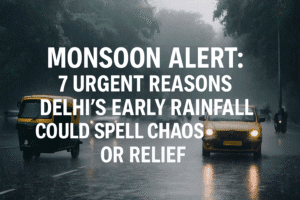Monsoon Alert: 7 Urgent Reasons Delhi’s Early Rainfall Could Spell Chaos or Relief
Delhi anticipates the Southwest Monsoon’s arrival tomorrow, June 24th, significantly ahead of its typical June 30th schedule, marking the earliest onset since 2013. The India Meteorological Department (IMD) has issued a Yellow Alert, urging residents to “be aware” of expected thunderstorms and rain citywide throughout Tuesday. This early arrival continues a recent pattern of timely or advanced monsoon entries, contrasting sharply with historical norms. Intriguingly, Delhi has already surpassed its entire June average rainfall (43.3 mm) with 89 mm recorded before the monsoon’s official start, highlighting substantial pre-monsoon activity.
The alert triggers necessary precautions against potential disruptions like waterlogging and travel delays, especially resonant after last year’s traumatic June 28th deluge of 228 mm. While promising vital relief from heat and improved air quality, the early rains also renew anxieties about urban flooding and infrastructure strain. Ultimately, this premature onset underscores shifting weather patterns and demands heightened civic and public readiness for the season’s dual potential: essential respite and inherent risk.

Monsoon Alert: 7 Urgent Reasons Delhi’s Early Rainfall Could Spell Chaos or Relief
The familiar scent of petrichor is set to arrive early in the national capital. According to the India Meteorological Department (IMD), the Southwest Monsoon is poised to sweep into Delhi on Tuesday, June 24th, significantly ahead of its typical schedule of June 30th. This early arrival, the earliest since 2013 (June 16th), signals the start of the rainy season but also comes with a caution: a Yellow Alert for rain and thunderstorms across the city tomorrow.
More Than Just a Few Days Early
While a week might seem minor, this early onset is part of a noticeable pattern in recent years:
- 2024: June 28th
- 2023: June 25th
- 2022: June 30th
- 2021: July 13th (significantly delayed)
The consistency of arrivals around or before the end of June in recent times, barring 2021, contrasts with the historical average and raises questions about shifting monsoon dynamics. If it arrives tomorrow, 2025 will mark the second earliest arrival in over a decade.
What the Yellow Alert Really Means for Delhiites
The IMD‘s Yellow Alert isn’t a signal for panic, but a clear call for heightened awareness and preparation:
- Expect Disruptions: Light to moderate rain and thunderstorms are forecast throughout Tuesday. This likely means waterlogging in vulnerable areas, slower traffic, and potential delays to travel plans (air, rail, road).
- Be Weather-Wise: Keep an eye on real-time updates, especially if commuting. Avoid waterlogged underpasses, be cautious of potential fallen branches or debris during gusts, and heed any advisories from authorities.
- Essential Prep: Ensure drainage around homes is clear, secure loose objects outdoors, and have essentials handy in case of brief power fluctuations common during storms.
A Paradox of Plenty… Already
Interestingly, Delhi has already surpassed its entire June average rainfall quota (43.3 mm) well before the monsoon’s official arrival, recording 89 mm so far from just three significant rainy days. This highlights how pre-monsoon activity has already been substantial.
The Ghost of June 2024
The memory of last year’s monsoon onset looms large. On June 28, 2024, Delhi was deluged by a record-breaking 228.1 mm of rain in a single day – nearly three times the monthly average – causing widespread chaos and flooding. While tomorrow’s forecast isn’t predicting anything near that extreme, the Yellow Alert serves as a crucial reminder of the monsoon’s potential ferocity and the city’s vulnerability to intense downpours.
The Human Impact: Beyond the Numbers
The early monsoon brings a complex mix:
- Relief: Promises respite from the intense pre-monsoon heat and dust, replenishes groundwater, and improves air quality – a major health benefit for residents.
- Anxiety: Raises concerns about flooding, infrastructure strain (power, roads, drainage), and the potential for disruption, especially after last year’s traumatic event.
- Agricultural Ripple: While crucial for the region’s agriculture, the timing and distribution of rain matter immensely for farmers in surrounding areas. An early onset doesn’t guarantee a good season, but it starts the clock on critical crop-growing periods.
Looking Ahead: Vigilance is Key
The early arrival of the monsoon in Delhi is a significant weather event. It offers hope for cooling rains and water security but demands respect and preparedness. The Yellow Alert is the first step – a signal for citizens and civic agencies to activate their monsoon protocols. How the season unfolds in terms of distribution and intensity remains to be seen, but Delhi is now officially on the monsoon clock, several days ahead of schedule. The coming days will test the city’s resilience and highlight whether lessons from last year’s floods have been truly learned.
You must be logged in to post a comment.